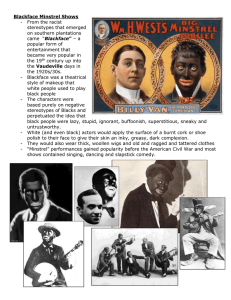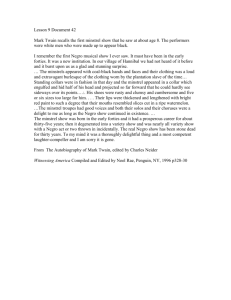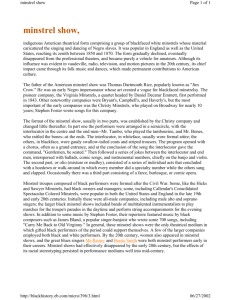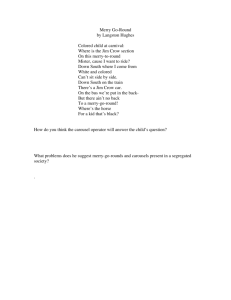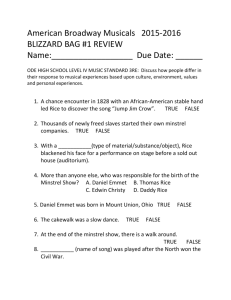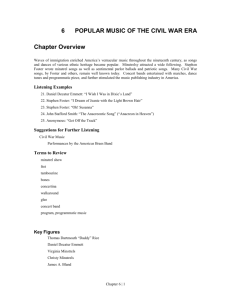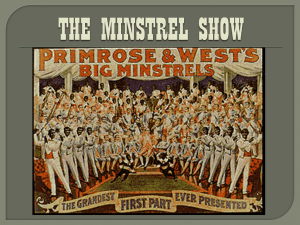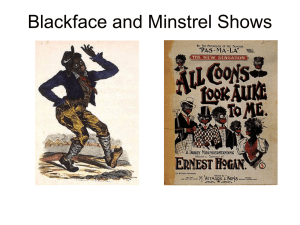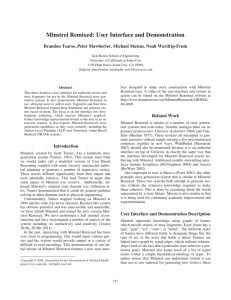WOM-17, Minstrel Shows
advertisement
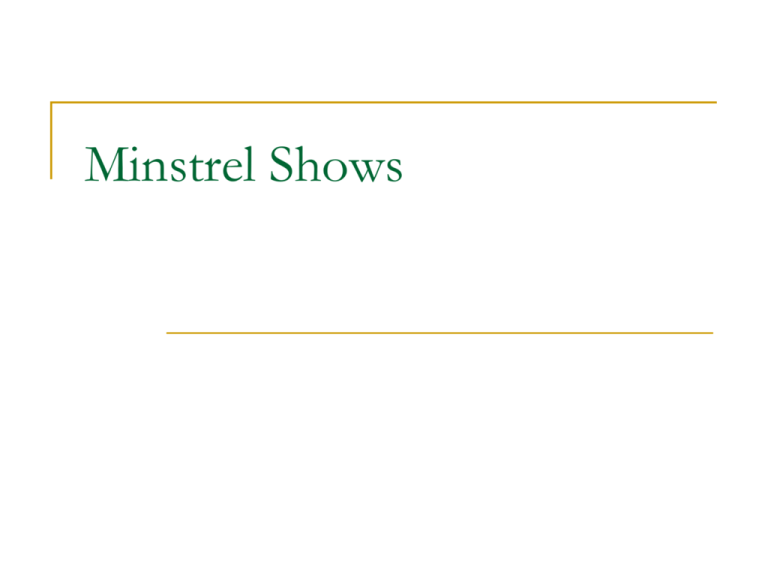
Minstrel Shows What are they? Working white class men dressing up as plantation slaves Called blackface performers Faces were painted black with burnt cork or grease Imitated/parodied black musical and dance forms All male until 1890 Origins of Minstrel Shows Emerged from European traditions of masking and carnivals Began in the U.S. in the 1830 Considered the first truly American form of music Is this racist? Of course! But times were much different In the time of the Greeks, there were no women’s rights, it was just a norm of society In the 19th century this was the norm – remember we are not that far removed from the Civil War (1860’s) https://www.youtube.com/watch?v=8ciHJv s9wPk The first rock star Thomas Dartmouth Rice Had his first “hit” in 1829 with a character named Jim Crow Not only a song – but an onstage persona as well. Who was Jim Crow? Character that reappeared in several minstrel shows, started by Rice Was a stereotypical carefree slave of the era Spoke in a mixed dialect White “backwoodsy” Black / creole (Caribbean) Who was Jim Crow? Was supposed to be a clown Looked down upon by the “upper class” as everything that was wrong with the “lower class” “lower class” here means not only blacks, but whites too Jump Jim Crow – c 1832 https://www.youtube.com/watch?v=T5FpKAxQNKU Come, listen, all you gals and boys, I'm just from Tuckyhoe; I'm gwine to sing a little song, My name's Jim Crow. Wheel about, an' turn about, an' do jis so; Eb'ry time I wheel about, I jump Jim Crow. I went down to de river, I didn't mean to stay, But there I see so many gals, I couldn't get away. I'm rorer on de fiddle, an' down in ole Virginny, Dey say I play de skientific, like massa Paganini. I cut so many munky shines, I dance de galloppade; An' w'en I done, I res' my head, on shubble, hoe or spade. I met Miss Dina Scrub one day, I gib her sich a buss; An' den she turn an' slap my face, an' make a mighty fuss. De udder gals dey 'gin to fight, I tel'd dem wait a bit; I'd hab dem all, jis one by one, as I tourt fit. I wip de lion ob de west, I eat de alligator; I put more water in my mouf, den boil ten load ob 'tator. De way dey bake de hoe cake, Virginny nebber tire; Dey put de doe upon de foot, an' stick 'em in de fire. Some of the performers in this genre were sensitive to the racial tensions of the time. They called themselves Ethiopian delineators instead of blackface performers Others….not so much. We got this instead: Zip Coon - 1834 The “coon” character was a variation of Jim Crow Slow-talking fool who avoided all work and responsibilities Lyrics The dialect is stereotypical, and upon reading/hearing is hard to understand. You might know it as …. “Turkey in the Straw” “Do Your Ears Hang Low” The “dance” that went along with this style of music was known as the cakewalk. Was an “Africanized” version of a European square dance Check out the next video and describe what you see. The five performers in this video are ACTUALLY black, not white. However, they are wearing “blackface” to make themselves look MORE black while on stage. This started occurring AFTER the Civil War! Blacks playing Whites playing Blacks Twisted? Yes, but this gave black performers a chance to perform for white audiences, and opened the doors for the future of the performance industry Ironic Twists The “cakewalk” was a dance that originated in the slave culture of the south, making fun of their owners. …became a standard of ballroom dancing in America later on in the century At the height of minstrel shows, you had black performers, wearing blackface, making fun of themselves to an audience of MIXED company Minstrelsy A form of entertainment consisting of music, comedy, skits, and variety acts, all parodying black culture in 19th century America. Minstrel shows were at the center of the rise of the American music industry – including the music, performers, and the audience. Al Jolson 1886-1950 One of the most famous names in the minstrel shows Not a racist – in fact, was credited with fighting for equal civil rights in the music industry. He openly befriended black performers at a time when it was unpopular to do so Jolson is quoted as saying that “blackface gave him emotional freedom”. Starred in the 1927 movie “The Jazz Singer” The FIRST movie that had sound synchronized to it Important Characters Mr. Tambo & Mr. Bones The Interlocutor The “end men” in a minstrel show The “master of ceremonies” Each show would also have a fair amount of other “supporting cast members” Mr. Bones & Mr. Tambo The comedy routine in between acts This can’t get any worse, right? From Minstrels to Vaudeville African Americans now given a chance to have their own stage roles HOWEVER – still forces to used stereotypes that originate in the minstrel tradition (stop at 7:40) https://www.youtube.com/watch?v=8kbnn3E7 Gp8 And just when did this stop…. http://www.youtube.com/watch?v=KoYOraDt 1_k Review Questions – in pairs How was the African American culture portrayed through minstrel songs? Why do you think minstrel shows were such a popular form of entertainment in the North? Is there a form of entertainment today that mirrors these minstrel shows?
